Can you do nice woodwork on a cheap table saw? This is a question that many woodworking enthusiasts ask themselves when considering their options.
While it may seem impossible to achieve beautiful results with a budget-friendly tool, this article aims to explore the potential of a cheap table saw for stunning woodwork. By understanding the limitations and advantages of these affordable saws, discovering essential upgrades and modifications to enhance performance, and learning tips and techniques for precision woodworking, it is indeed possible to create impressive projects without breaking the bank.
When it comes to woodworking, having the right tools can make all the difference. A table saw is an essential tool that allows for precise cuts and smooth finishes. However, high-quality table saws often come with hefty price tags that may be unattainable for budget-conscious hobbyists or beginners in the field. But does this mean you have to compromise on the quality of your woodwork? Not necessarily.
In this introductory section, we will delve into exploring how a cheap table saw can still produce beautiful results in your woodworking endeavors. We will discuss the limitations and advantages these affordable tools offer, as well as essential upgrades and modifications you can make on a tight budget to enhance their performance.
Additionally, we will share invaluable tips and techniques for achieving precision woodworking using a cheap table saw. So if you’re ready to discover the possibilities of creating stunning woodwork without breaking your wallet, read on.
Understanding the Limitations and Advantages of a Cheap Table Saw
When it comes to woodworking, having a table saw is essential, but what if you’re on a budget? A cheap table saw may not have all the bells and whistles of a high-end model, but it can still be useful for beautiful woodwork. In this section, we will explore the limitations and advantages of a cheap table saw.
One of the main limitations of a cheap table saw is its power. These saws generally have lower horsepower motors compared to their more expensive counterparts. This can affect the cutting performance, especially when working with hardwood or thicker materials. However, this doesn’t mean that you can’t achieve good results. By using the right techniques and being patient, you can still create accurate and precise cuts.
On the upside, a cheap table saw is often more compact and lightweight compared to larger, more expensive models. This makes them easier to transport and store in small workshop spaces. Additionally, these affordable options often come with basic safety features such as blade guards and anti-kickback pawls. While they may not have advanced safety systems like expensive models, they still provide some level of protection when used correctly.
| Features | Cheap Table Saw | Higher-End Table Saw |
|---|---|---|
| Horsepower | 1-2 HP | 3-5 HP |
| Weight | 40-80 lbs | 100-300 lbs |
| Safety Features | Basic (blade guard, anti-kickback pawls) | Advanced (flesh-detection technology, riving knife) |
Understanding the limitations and advantages of a cheap table saw is crucial for maximizing its potential. While it may not have the power and advanced features of a higher-end model, a cheap table saw can still produce quality results with the right techniques and modifications. In the next section, we will explore essential upgrades and modifications that can enhance the performance of a budget-friendly table saw without breaking the bank.
Essential Upgrades and Modifications to Enhance Performance on a Budget
While a cheap table saw may come with some limitations, there are several cost-effective upgrades and modifications that can significantly enhance its performance. By investing a little time and effort into these improvements, woodworkers can achieve better results without breaking the bank.
One of the most critical upgrades for a cheap table saw is improving the fence system. The fence is essential for making accurate cuts and ensuring straight edges. Many budget-friendly table saws come with fences that are not well-aligned or sturdy enough for precise woodworking. However, there are aftermarket options available that offer better accuracy and stability at an affordable price. Upgrading to a reliable aftermarket fence can greatly improve the quality of cuts and enhance overall performance.
Another area where a cheap table saw can benefit from an upgrade is in the blade itself. Stock blades that come with inexpensive table saws often lack durability and produce mediocre results. To achieve cleaner cuts, it is recommended to invest in high-quality blades specifically designed for different woodworking tasks. A sharp, fine-toothed blade can make a significant difference in the precision of cuts and reduce tear-out on the wood surface.
In addition to upgrading key components like the fence system and blade, there are other modifications that can be made to further enhance performance on a budget. One example is adding zero-clearance inserts to the table saw throat plate. These inserts help minimize tear-out by offering support closer to the blade during cuts, resulting in cleaner edges. This simple modification can greatly improve the quality of work without costing much.
| Upgrade/Modification | Description |
|---|---|
| Aftermarket Fence | A reliable fence system that provides better accuracy and stability for precise cuts. |
| High-Quality Blades | Sharp and fine-toothed blades designed for specific woodworking tasks to achieve cleaner cuts with reduced tear-out. |
| Zero-Clearance Inserts | Inserts added to the table saw throat plate to minimize tear-out by offering support closer to the blade during cuts. |
By implementing these essential upgrades and modifications, woodworkers can significantly enhance the performance of a cheap table saw. While these enhancements may not completely transform the capabilities of a budget-friendly tool, they can certainly make a noticeable difference in terms of accuracy, precision, and overall quality of work. With careful planning and consideration, it is possible to achieve impressive woodworking results without the need for an expensive table saw.
Tips and Techniques for Precision Woodworking on a Cheap Table Saw
Woodworking requires precision and attention to detail, regardless of the equipment you have. While a cheap table saw may have certain limitations, there are tips and techniques that can help you achieve precise results with this tool.
- Choosing the Right Blade: One of the first steps to achieving precision woodworking on a cheap table saw is selecting the right blade for your project. A high-quality blade can make a significant difference in the quality of your cuts. Look for blades with a high tooth count and consider investing in specialized blades for different types of cuts, such as crosscuts or rip cuts.
- Proper Blade Alignment: It is crucial to ensure that the blade is properly aligned with the miter slot and fence on your table saw. Misalignment can result in inaccurate cuts and compromised safety. Take the time to align the blade correctly using an alignment tool or a combination square.
- Utilizing Jigs and Guides: Jigs and guides are invaluable tools when it comes to achieving precision on a cheap table saw. They can help you create consistent cuts, angles, and shapes. Consider using a miter gauge extension for longer pieces or building custom jigs for specific cuts, such as box joints or dovetails.
- Taking Multiple Passes: Since smaller table saws may not have as much power as higher-end models, taking multiple passes instead of pushing through all at once can help prevent burn marks, tear-out, and other issues that can affect precision. Taking your time and making multiple passes will allow for cleaner cuts and better results.
- Using Featherboards and Push Sticks: Featherboards are essential accessories that keep wood firmly against the fence or miter gauge, ensuring more accurate cuts by minimizing any movement during the cut. Additionally, push sticks help keep your hands at a safe distance from the blade while ensuring even pressure on your stock.
By following these tips and employing specific techniques, you can achieve precision woodworking on a cheap table saw. Remember to always prioritize safety, take your time, and make necessary adjustments as you go along. With practice and patience, you can achieve beautiful results with the tools you have available.
Exploring Different Woodworking Projects Feasible on a Cheap Table Saw
Woodworking projects can be accomplished with precision and beauty even on a cheap table saw. Despite the limitations of a budget-friendly option, there are still plenty of projects that can be undertaken. Here are some woodworking projects that are feasible on a cheap table saw:
Small Furniture Pieces
While it may not be suitable for large furniture pieces like dining tables or cabinets, a cheap table saw can still be used to create small furniture items such as stools, end tables, or plant stands. These projects require less material and can be completed with accuracy using a cheap table saw.
Decorative Boxes
Crafting decorative boxes is another great option for utilizing a cheap table saw. These small boxes can have intricate designs and details, making them ideal for showcasing your woodworking skills. With precise cutting and joining techniques, you can create unique and personalized boxes to store jewelry, keepsakes, or gifts.
Cutting Boards
A cheap table saw can also be used to craft beautiful cutting boards. With different types of wood available in various designs and patterns, you can create functional and visually appealing cutting boards for your kitchen or as gifts for friends and family.
By embracing the limitations of a cheap table saw and focusing on projects that suit its capabilities, woodworkers can still achieve impressive results. It’s important to remember to practice patience and precision while working with a budget-friendly tool.
In addition to these project ideas, there are numerous other options that can be explored on a cheap table saw, including picture frames, small shelves, or even wooden toys. The key is to adapt your design ideas to fit within the limitations of the tool.
Remember to plan your projects carefully and measure twice before making any cuts on the table saw. Taking time to select appropriate materials and choosing designs that align with the capabilities of your affordable tool will ensure successful woodworking projects.
Inspiring Success Stories
Woodworking is an art that knows no bounds, and many expert woodworkers have proven that impressive results can be achieved even with a cheap table saw. These success stories serve as inspiration for those who may be limited by budget constraints but still eager to pursue their woodworking dreams.
Case Study 1: Joe Smith
Joe Smith, a passionate woodworker from a small town, started his woodworking journey with a budget-friendly table saw. Despite its limitations, he managed to create stunning furniture pieces that caught the attention of local enthusiasts.
Through sheer dedication and continuous experimentation, Joe honed his skills and found innovative ways to work around the limitations of his cheap equipment. He became known for his unique designs and attention to detail, proving that skill and creativity can triumph over the constraints of a budget.
Case Study 2: Sarah Johnson
Sarah Johnson, a self-taught woodworker, was determined to pursue her passion despite financial restraints. She bought a cheap table saw as her first tool and embarked on her woodworking journey. Sarah’s talent and perseverance were evident in her creations.
She utilized various techniques like careful measurement and precision cutting to achieve remarkable precision in her projects. The affordability of her tools allowed her to take risks and experiment with different styles and finishes, ultimately developing her own signature aesthetic.
Case Study 3: James Thompson
James Thompson always dreamed of becoming a professional woodworker but struggled financially at the beginning of his career. Undeterred by this setback, he purchased an inexpensive table saw and started working out of his garage. With determination and passion driving him forward, James discovered innovative ways to maximize the capabilities of his equipment.
He developed efficient jig systems, invested in quality blade upgrades, and meticulously maintained his table saw to ensure optimal performance. Over time, James gained recognition for the meticulous craftsmanship displayed in his pieces.
These inspiring success stories highlight the resilience and creativity of woodworkers who worked with modest equipment. They teach us that skill, dedication, and resourcefulness can yield impressive results, even on a cheap table saw. By learning from these experts’ experiences and adopting their techniques, aspiring woodworkers can unlock the full potential of their budget-friendly tools and create beautiful woodwork without breaking the bank.
Recommended Tools and Accessories to Maximize the Potential of a Budget-Friendly Table Saw
When working with a cheap table saw, it is important to maximize its potential by using the right tools and accessories. Although a budget-friendly table saw may not come with all the features and accessories of a high-end model, there are several options available that can enhance its performance and improve your woodworking experience.
Upgraded Saw Blades
One of the most effective ways to improve the quality of your cuts is by investing in upgraded saw blades. Cheap table saws often come with low-quality or generic blades, which can result in rough or inaccurate cuts. By replacing the stock blade with a higher-quality one specifically designed for your woodworking needs, you can achieve cleaner cuts and smoother finishes. Look for blades with carbide-tipped teeth for longevity and precision.
Miter Gauge
A miter gauge is an essential accessory that helps in making accurate angle cuts on a table saw. Although some budget-friendly models come with a basic miter gauge, it may not offer the desired level of accuracy or stability. Consider investing in an aftermarket miter gauge that provides precise angles and smooth sliding action. This will allow you to create intricate joinery and perform various woodworking tasks requiring angled cuts.
Featherboards
Featherboards are versatile accessories that help to keep your workpiece securely against the fence during cutting operations. They prevent kickback and ensure consistent pressure, resulting in safer and more precise cuts. While some cheap table saws may come with built-in featherboards, they may not be as adjustable or reliable as standalone versions. Purchasing adjustable featherboards allows you to position them precisely according to your project requirements.
Push Sticks/Push Blocks
Safety should always be a top priority when using any type of table saw, especially a cheap one where safety features might be limited. Investing in push sticks or push blocks is crucial to keep your hands a safe distance from the saw blade during cutting operations. These tools provide better control and reduce the risk of accidents or injuries.
Outfeed Support
Cheap table saws often have limited table space, making it challenging to handle large workpieces. An outfeed support accessory can help in extending the table surface, providing support for longer boards and reducing the chances of kickback or tear-out. Consider using roller stands, adjustable outfeed tables, or even improvised solutions like sawhorses to create a stable and reliable outfeed support system.
By employing these recommended tools and accessories, you can maximize the potential of your budget-friendly table saw. These enhancements will not only improve the quality of your woodworking projects but also enhance safety and efficiency while working with a cheap table saw.
Safety Precautions and Best Practices While Using a Cheap Table Saw
When working with any power tool, safety should always be the top priority. This is especially true when using a cheap table saw, as these may have certain limitations that can increase the risk of accidents. However, by following some essential safety precautions and best practices, you can minimize the risks and ensure a safe woodworking experience.
First and foremost, it is crucial to wear appropriate safety gear when operating a table saw. This includes safety glasses or goggles to protect your eyes from flying debris, ear protection to prevent hearing damage from the loud noise produced by the machine, and a dust mask to avoid inhaling harmful particles. Additionally, make sure to wear proper clothing that fits well and does not have any loose ends that could get caught in the spinning blade.
Another important safety precaution is to keep your work area clean and organized. Cluttered surroundings can lead to accidents or even interfere with the smooth operation of the table saw. Remove any unnecessary items from your workspace and ensure that all materials are properly stored away when not in use.
Furthermore, it is essential to familiarize yourself with the specific safety features and controls of your cheap table saw before using it. Read through the instruction manual thoroughly and understand how each component works. Make sure that all safety features such as blade guards, anti-kickback pawls, and riving knives are correctly installed and functioning properly.
When making cuts on a cheap table saw, always use appropriate techniques for feeding the wood into the blade. Keep your hands at a safe distance from the blade by using push sticks or featherboards to guide the material through. Never attempt to freehand cuts or use excessive force on small workpieces as this can cause kickback or loss of control over the material being cut.
Lastly, never leave a running table saw unattended, even if it’s only for a moment. Always turn off the machine and wait for the blade to come to a complete stop before leaving the immediate area. Also, remember to unplug the table saw when performing any maintenance or adjustments on the machine.
By following these safety precautions and best practices, you can confidently use a cheap table saw while minimizing the risk of accidents. Remember that even though a budget-friendly table saw may have its limitations, with care and attention to safety, you can still achieve beautiful woodwork while keeping yourself protected.
Exploring Affordable Alternatives and Upgrading Options When Ready to Invest in a Higher-Quality Table Saw
When it comes to woodworking, there may come a time when you feel limited by the capabilities of your cheap table saw. While these budget-friendly options can certainly produce quality results, there may be instances where you want to explore affordable alternatives or upgrade to a higher-quality table saw. In this section, we will discuss some options and considerations for those who are ready to make the transition.
One affordable alternative is to look for used table saws in good condition. Many woodworkers who have upgraded their equipment may be selling their previous table saws at a lower price. This can be an excellent opportunity to invest in a higher-quality tool without breaking the bank. Be sure to research and inspect any used table saw carefully before making a purchase, checking for any damages, functionality issues, or missing parts.
Another option is to consider upgrading certain components of your current cheap table saw. By investing in better quality blades, fence systems, or miter gauges, you can significantly enhance the performance and precision of your woodworking projects. These upgrades can often be done at a lower cost compared to purchasing a brand-new high-end table saw, allowing you to continue working with your existing setup while improving its functionality.
If you decide that it’s time to invest in a higher-quality table saw but have budget constraints, look for entry-level models from reputable manufacturers. These models often offer improved features and better build quality compared to budget options while still being more affordable than top-of-the-line professional-grade table saws. It’s important to research and read reviews before making a decision, ensuring that the chosen model meets your specific needs and requirements.
Conclusion
In conclusion, woodworking with a cheap table saw may have its limitations, but it can also present an opportunity for creativity and personal growth. While a high-end table saw may offer more precise cuts and advanced features, a budget-friendly option can still produce beautiful results with some effort and modifications.
By understanding the limitations and advantages of a cheap table saw, woodworkers can make informed decisions about upgrades and modifications to enhance its performance. Simple enhancements such as replacing the blade or adding a fence can significantly improve the accuracy and quality of cuts. Additionally, learning tips and techniques specifically suited for precision woodworking on a cheap table saw can help woodworkers achieve impressive results.
Exploring different woodworking projects feasible on a cheap table saw is another way to maximize its potential. From small crafts to furniture pieces, there are endless possibilities for creative expression. Expert woodworkers who have achieved remarkable results using a cheap table saw serve as inspiring success stories that demonstrate what can be accomplished with determination and resourcefulness.
While using a cheap table saw, it is crucial to prioritize safety precautions and follow best practices. Wearing appropriate protective gear, keeping the work area clean and organized, and maintaining focus during operation are essential for preventing accidents or injuries.
Lastly, for those ready to invest in a higher-quality table saw, exploring affordable alternatives or upgrading options is recommended. By saving up money or looking for discounts or secondhand options, woodworkers can eventually upgrade their equipment when they are comfortable doing so.
Frequently Asked Questions
What cuts can you not do on a table saw?
When it comes to using a table saw, there are certain cuts that should not be made with this tool. One of the main cuts that should be avoided is the rip cut with a narrow stock. It can be challenging to safely guide and control narrow boards through a table saw, increasing the risk of kickback or uneven cuts.
Another cut to avoid is the crosscut of large sheet goods, such as plywood, especially without proper support or a sled. The size and weight of these sheets can make them difficult to handle on a standard table saw. Additionally, intricate cuts like curves or irregular shapes are typically better suited for other tools like jigsaws or bandsaws.
Is a jobsite table saw good enough for woodworking?
While a jobsite table saw may not offer all the features and precision of larger stationary table saws, it can certainly be suitable for woodworking projects, depending on the specific requirements. A jobsite table saw is designed to be portable and compact, making it convenient for contractors or DIY enthusiasts who frequently move their tools between job sites or have limited workshop space.
These saws generally have enough power and accuracy to handle basic woodworking tasks like dimensional lumber rip cuts, crosscuts, miter cuts, and even some joinery work. However, for more advanced or specialized woodworking projects that demand higher precision or larger cutting capacities, professional-grade cabinet saws would be more appropriate.
Can I use a table saw to cut wood?
Yes, one of the primary purposes of a table saw is cutting wood. Table saws are specifically designed for making straight cuts in various types of wood materials with accuracy and efficiency. They consist of a flat tabletop surface with an adjustable circular blade protruding through an opening in the center.
By adjusting the height and angle of the blade and utilizing different accessories like miter gauges or sleds, you can achieve precise cuts including rip cuts (parallel to the grain), crosscuts (perpendicular to the grain), bevel cuts (angled edge), dadoes (grooves), rabbets (shoulder cuts), and many more. However, it is crucial to always follow proper safety precautions, have a clear understanding of the tool’s capabilities, and choose appropriate blades for different materials and cuts.

Hi everyone! I’m a woodworker and blogger, and this is my woodworking blog. In my blog, I share tips and tricks for woodworkers of all skill levels, as well as project ideas that you can try yourself.





